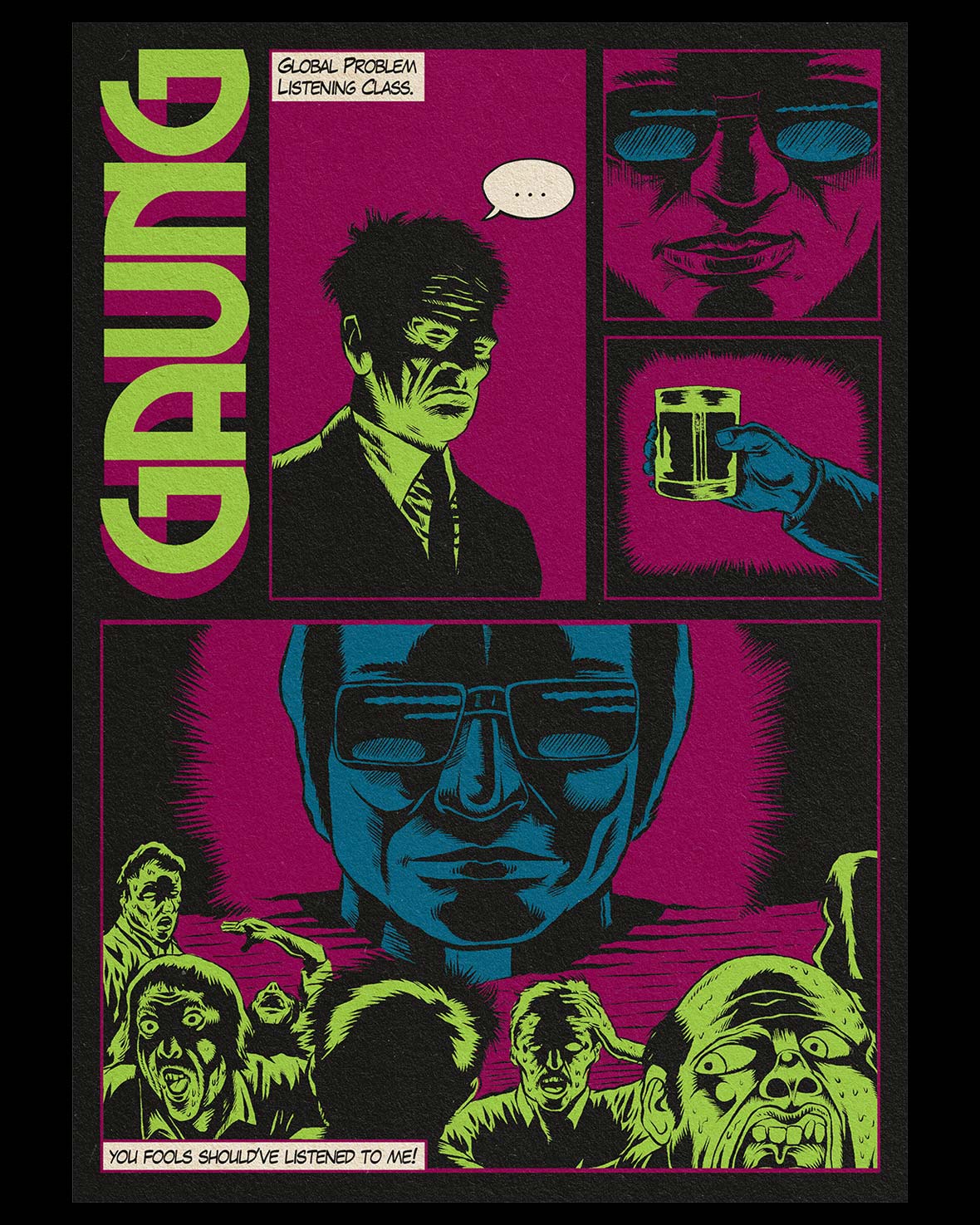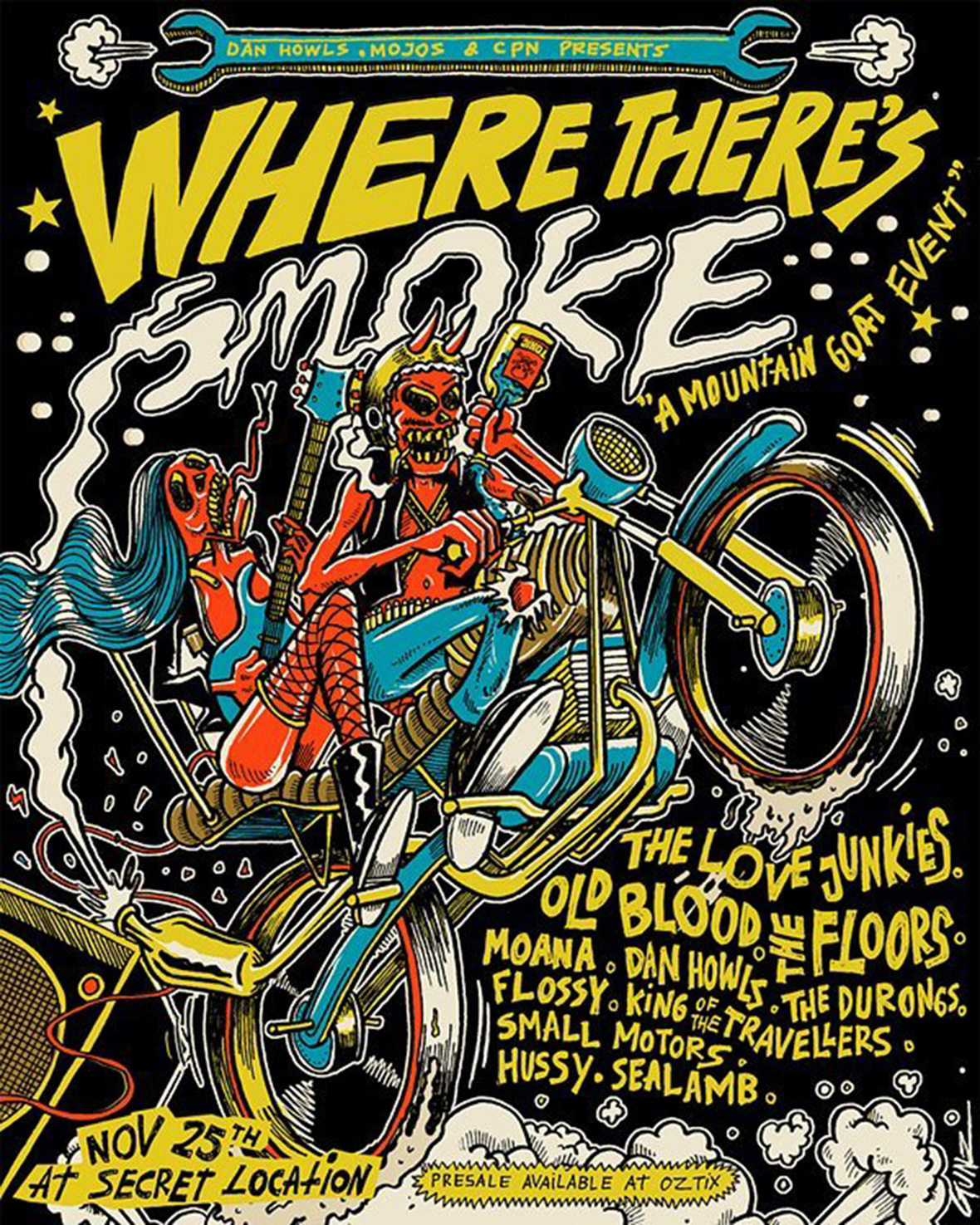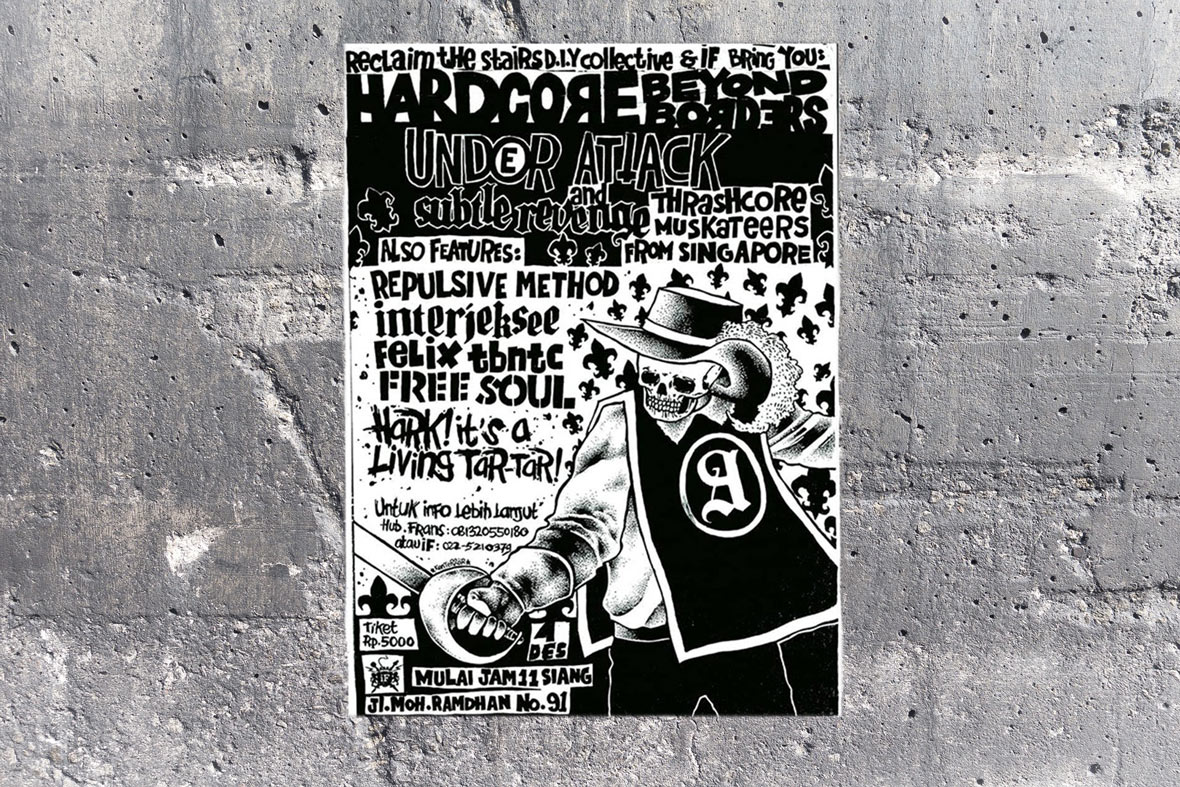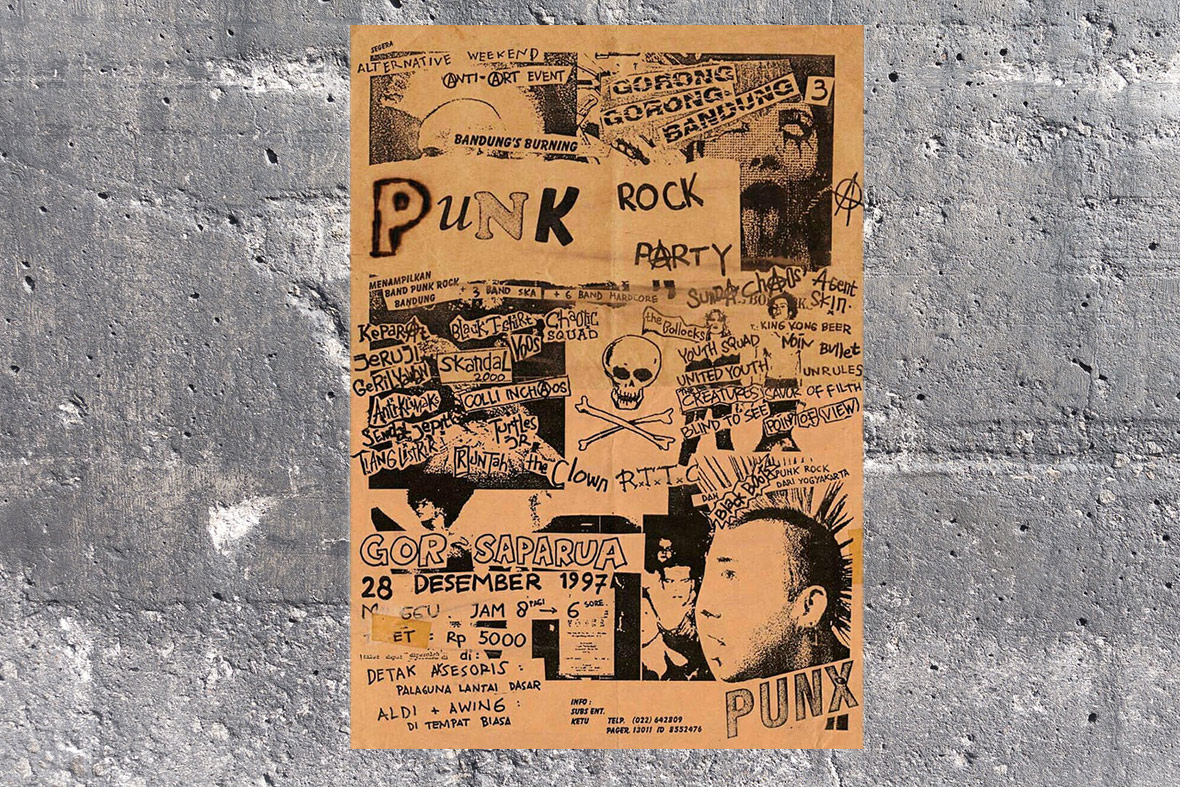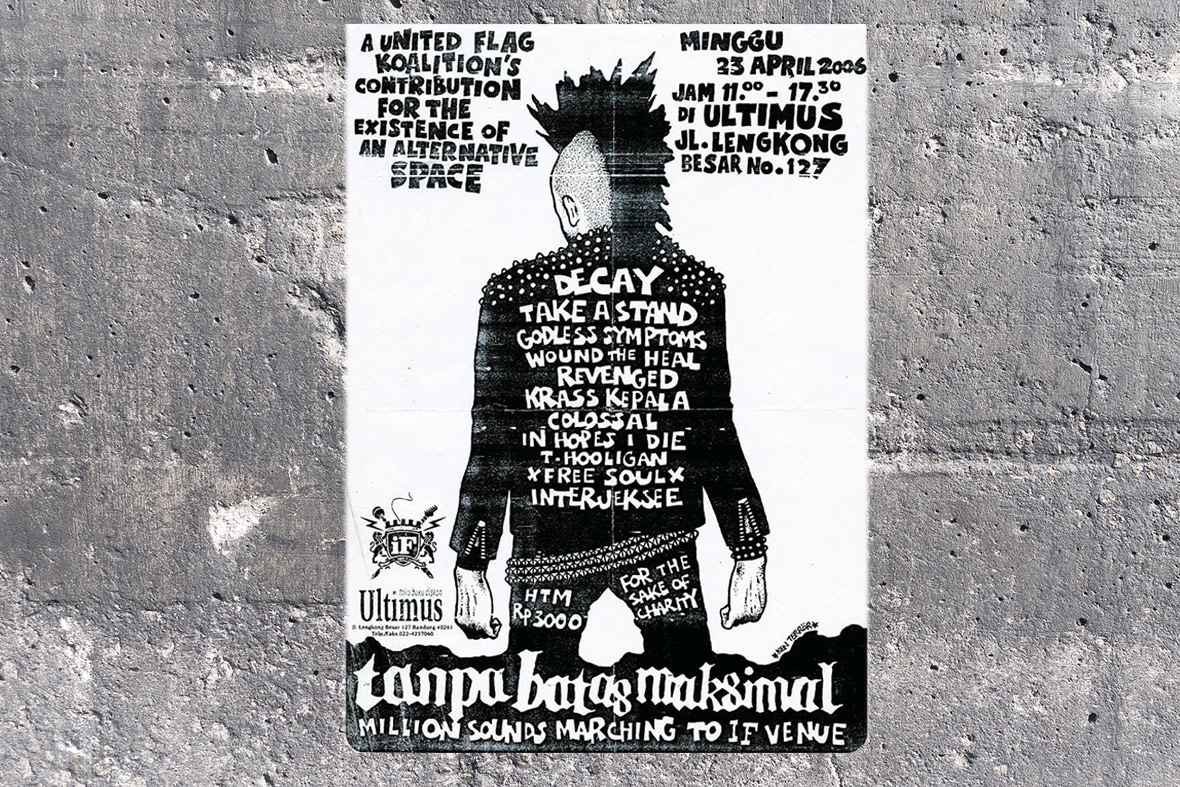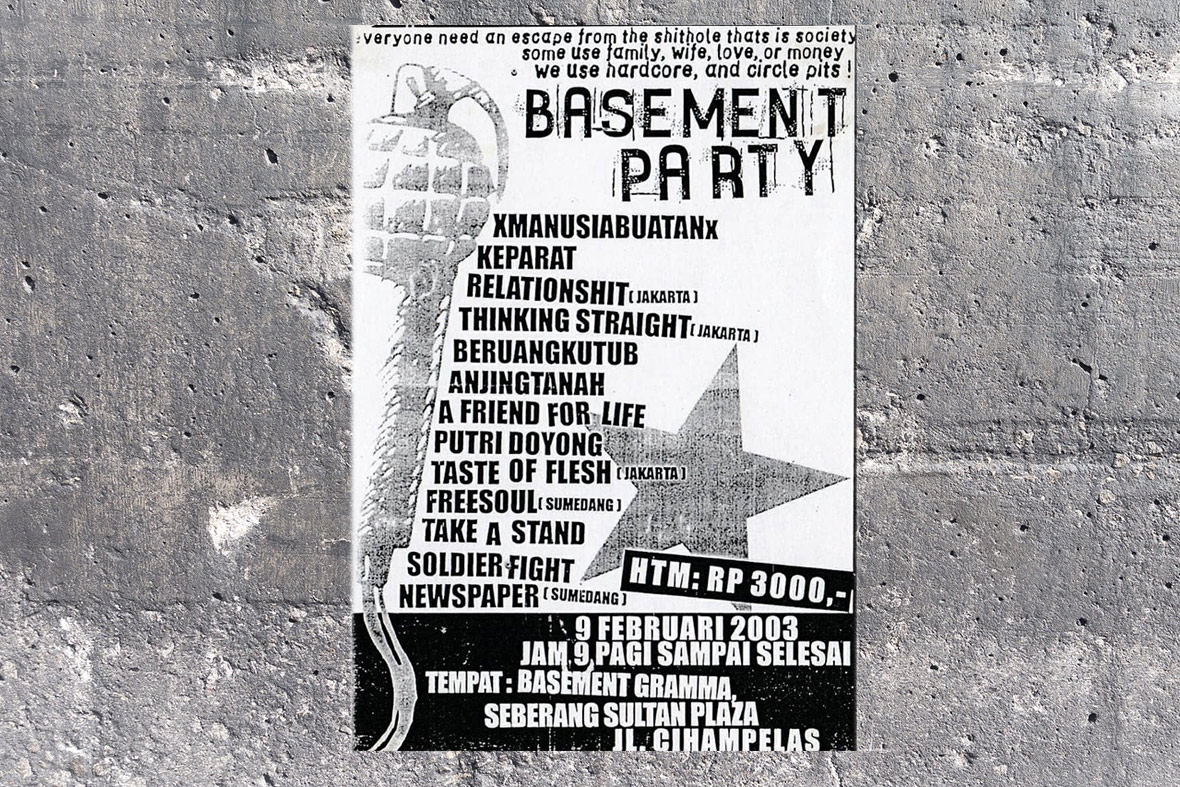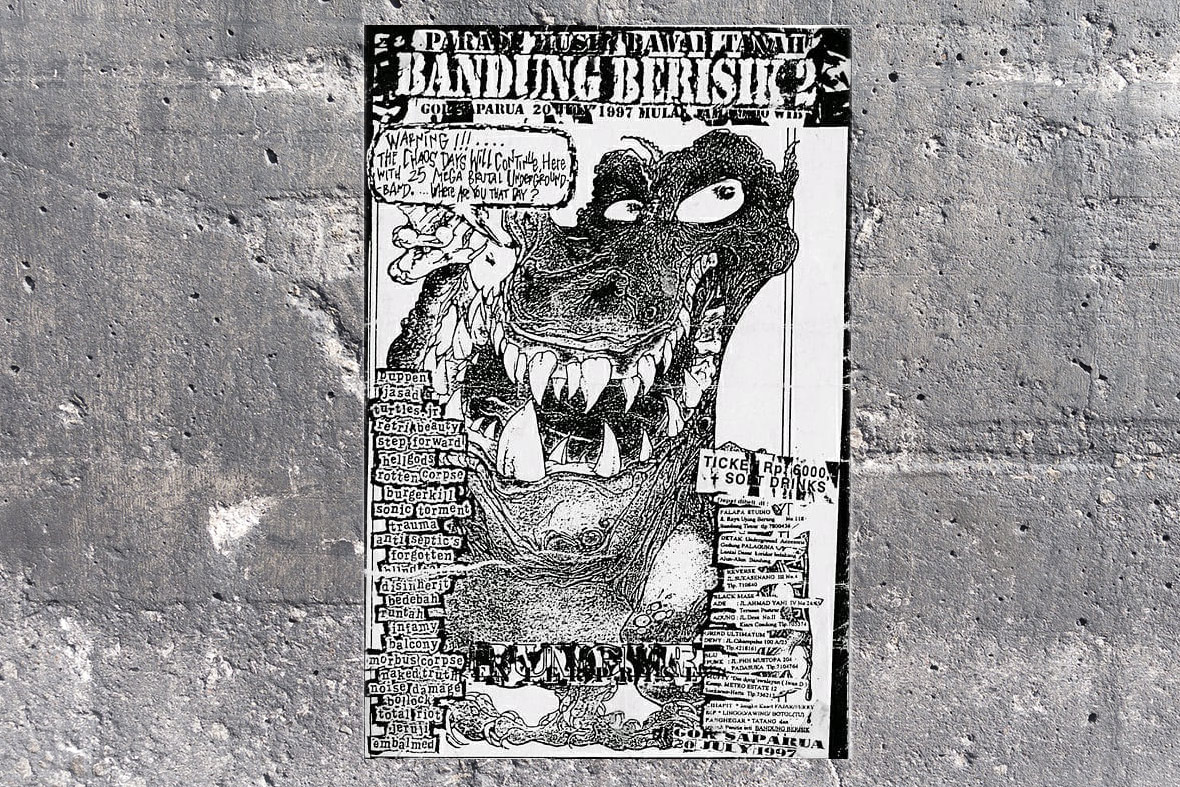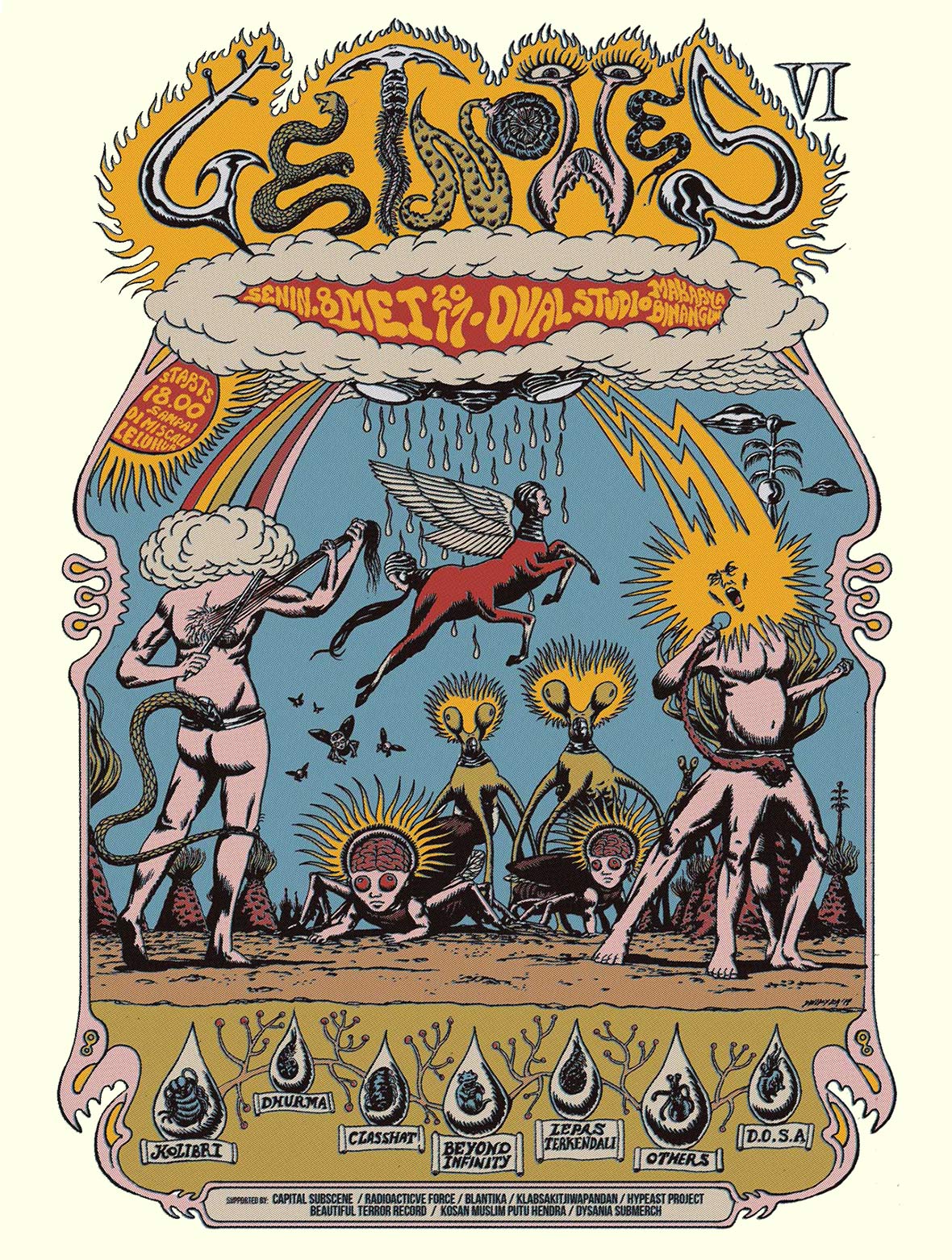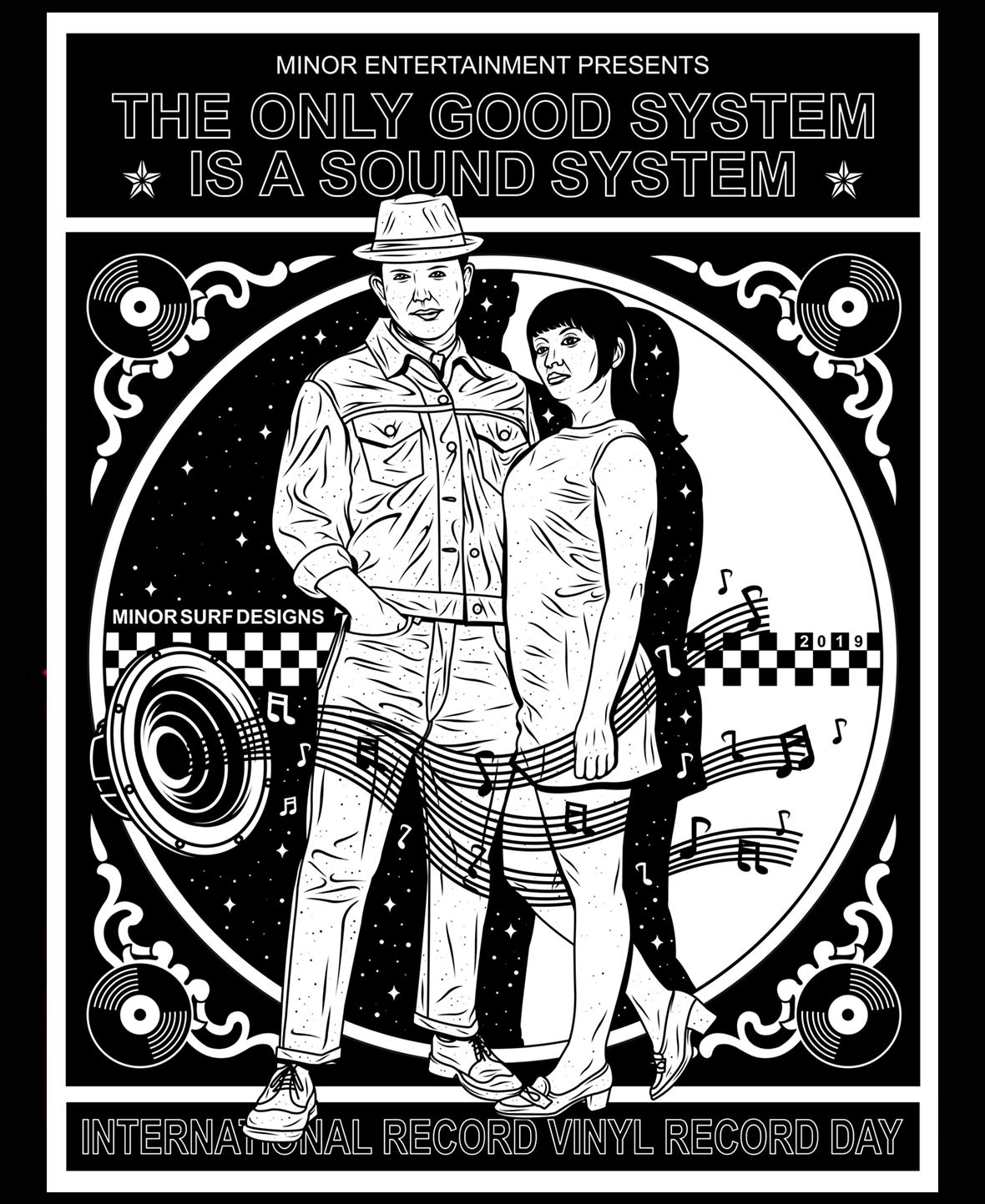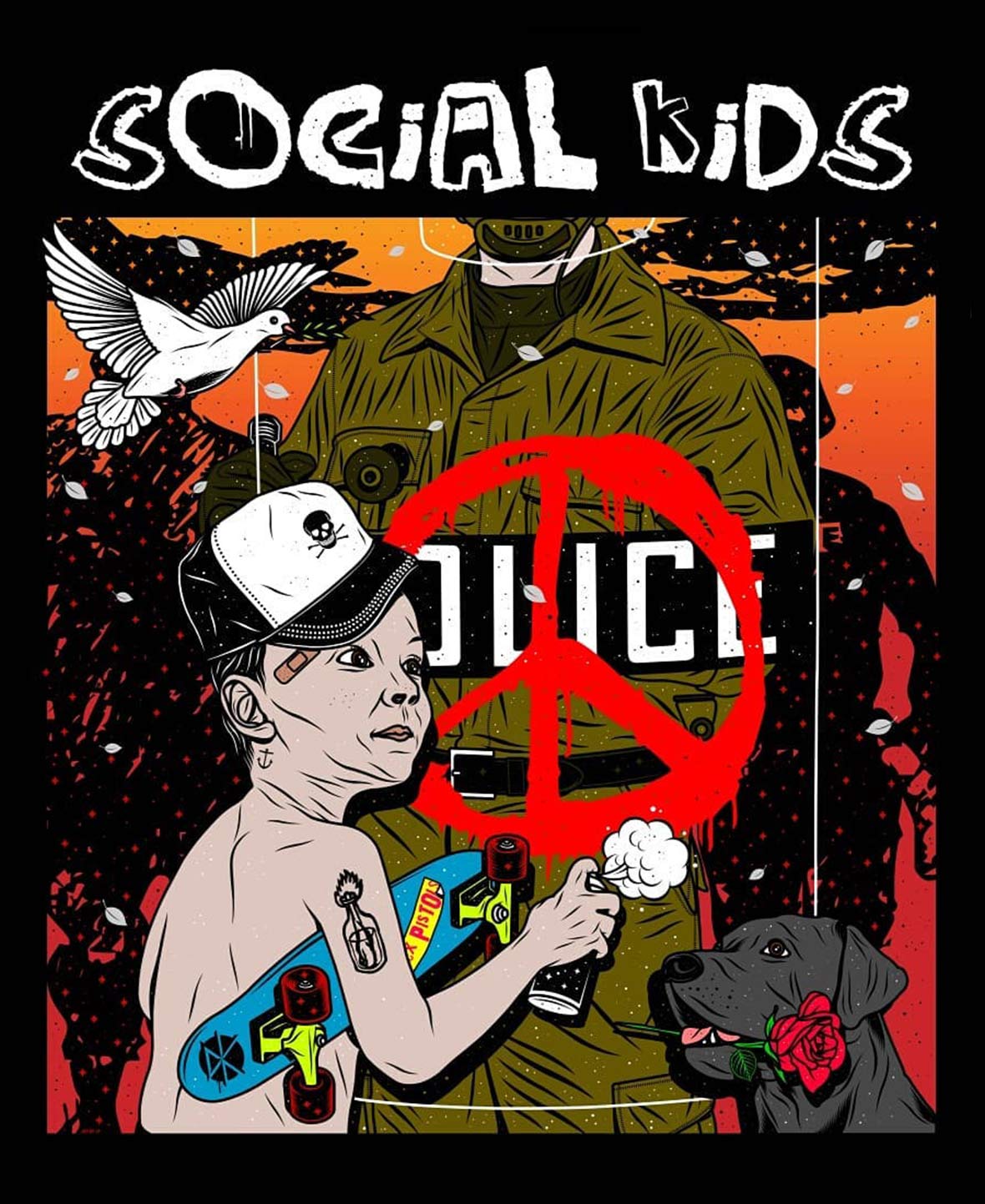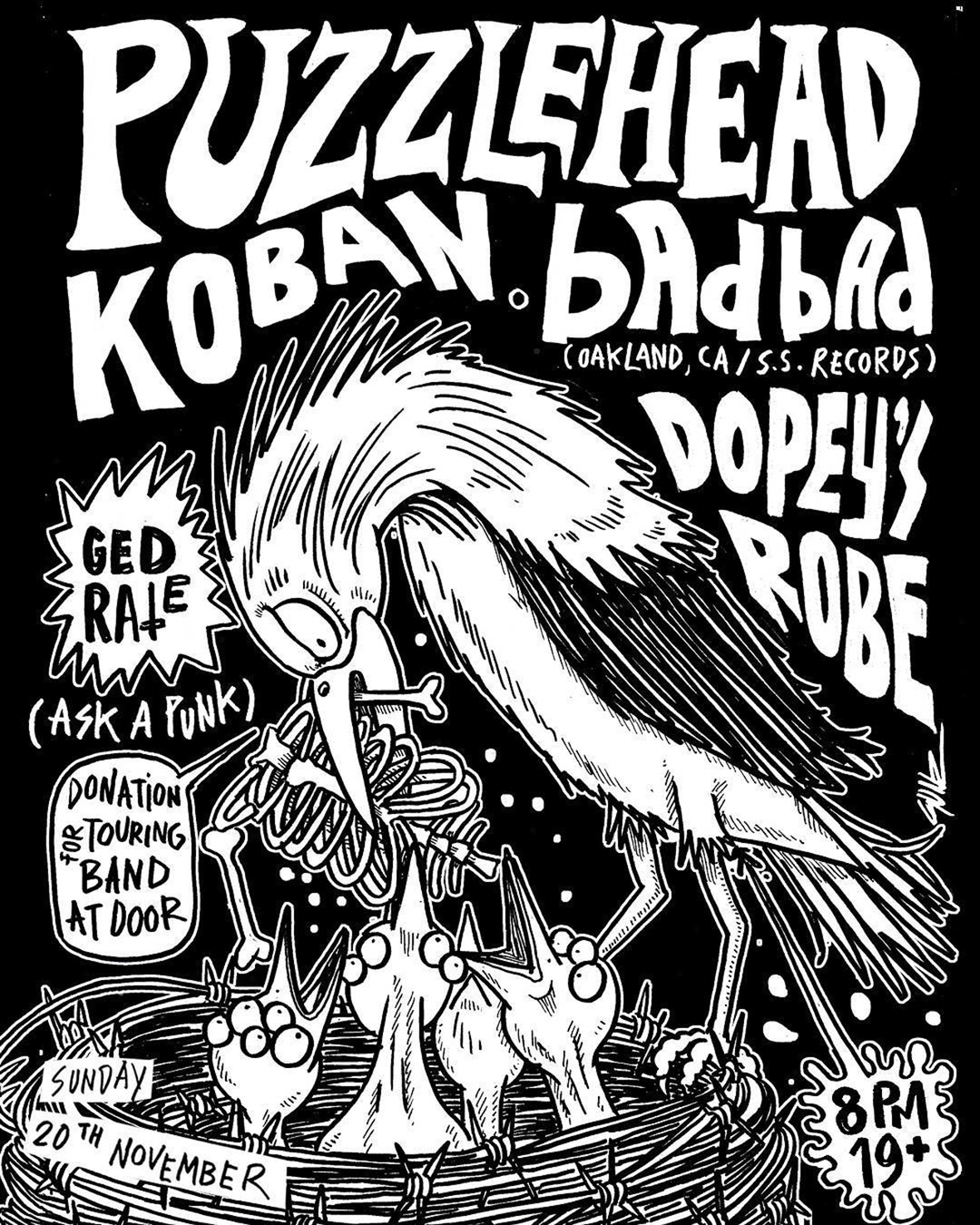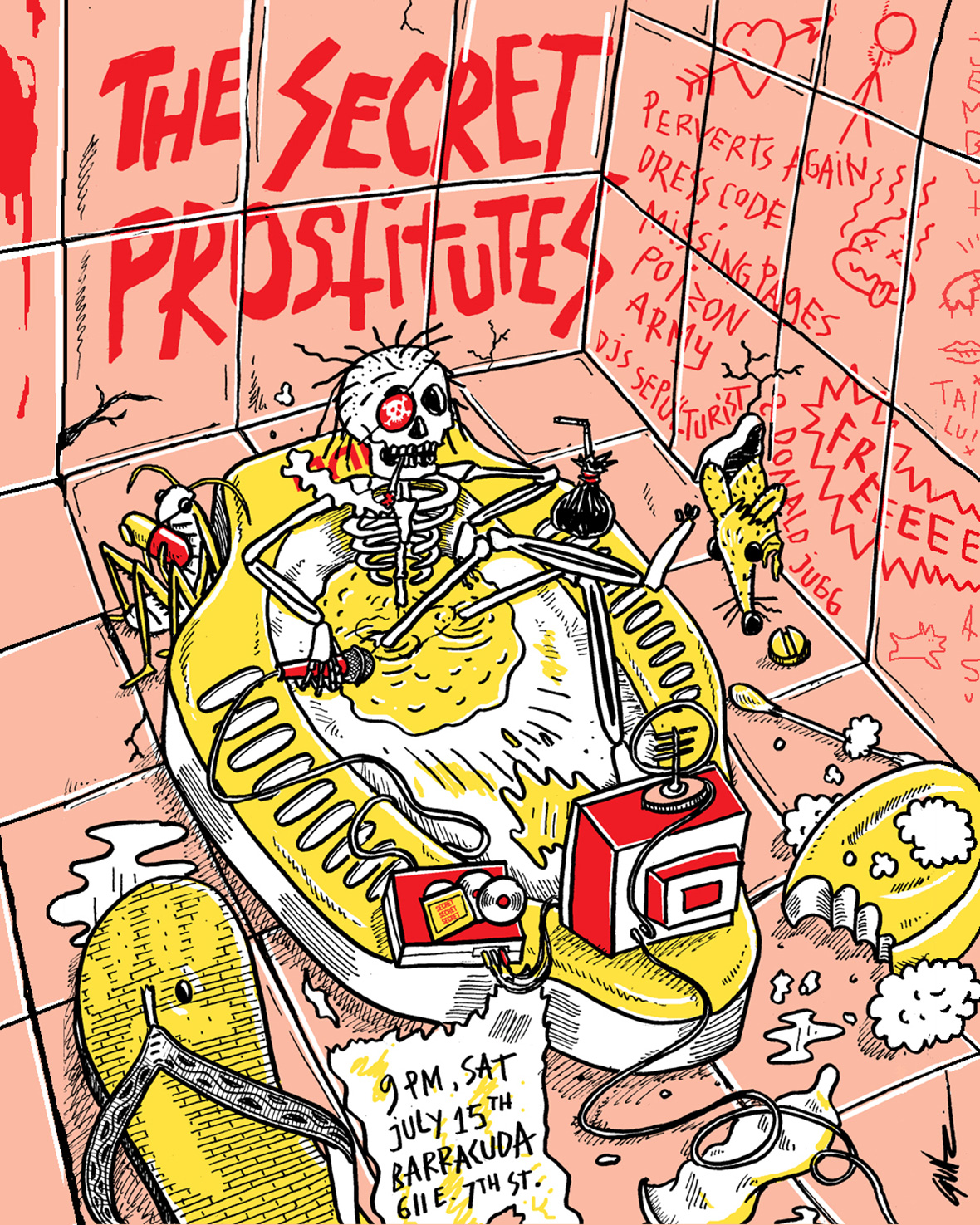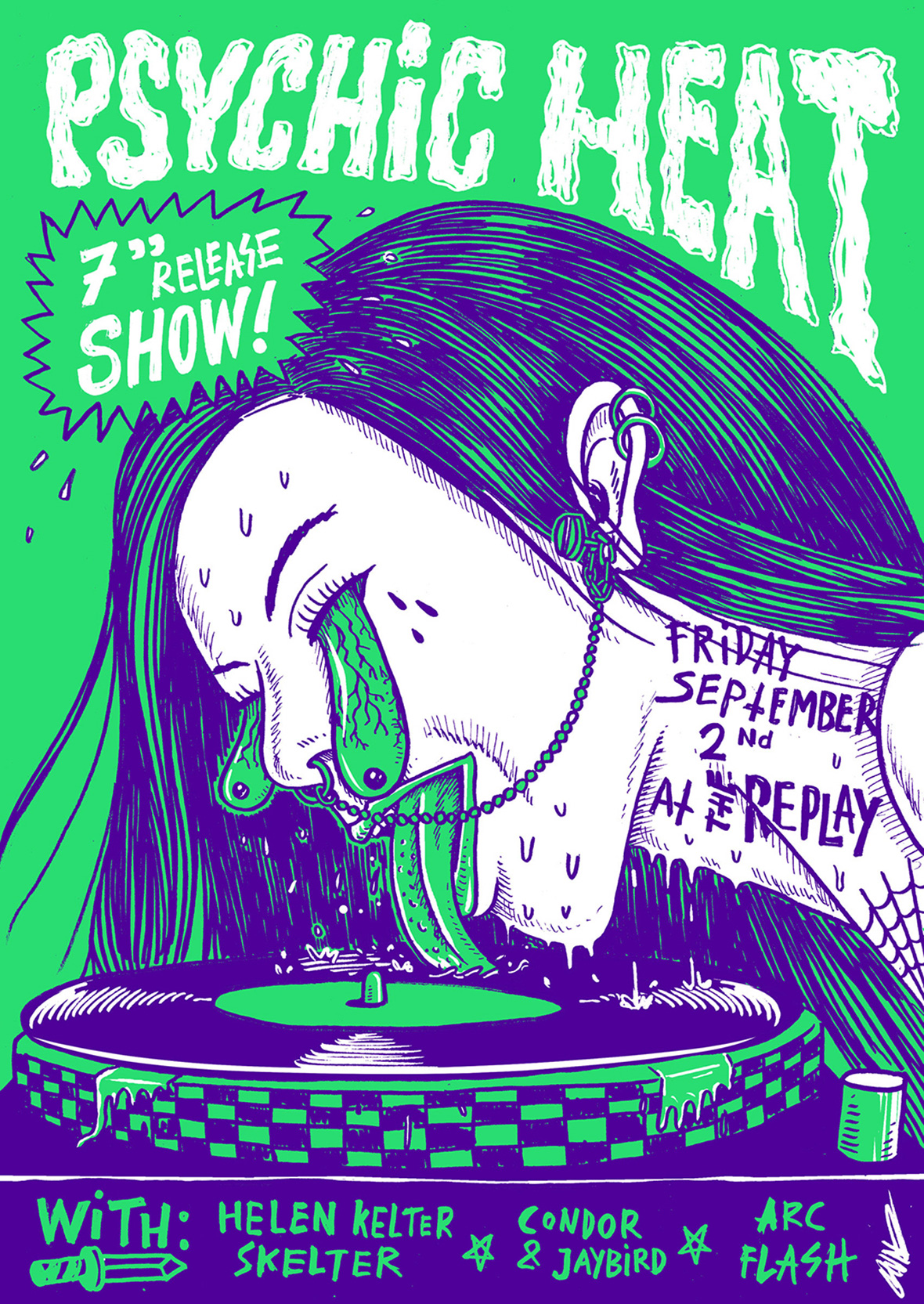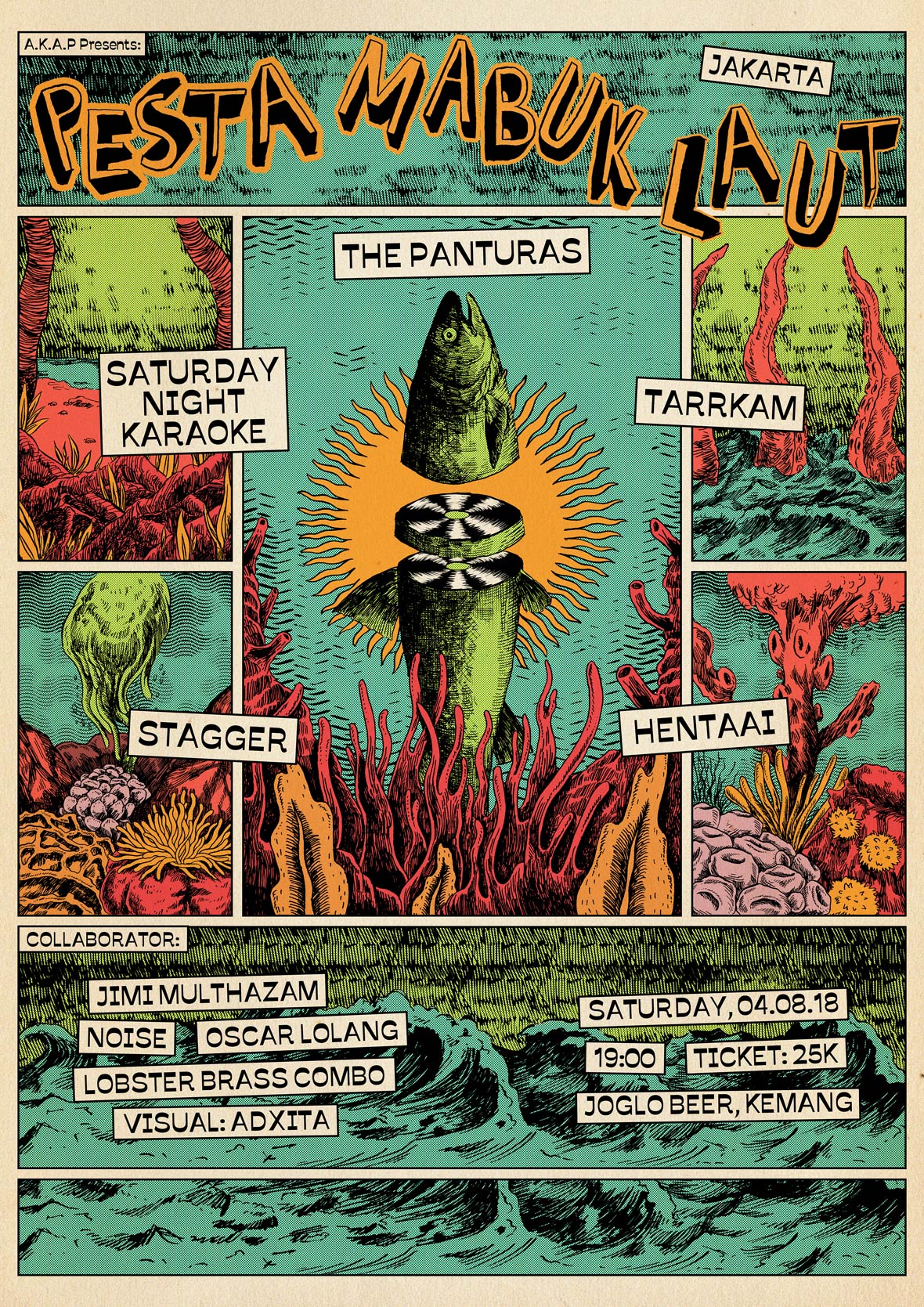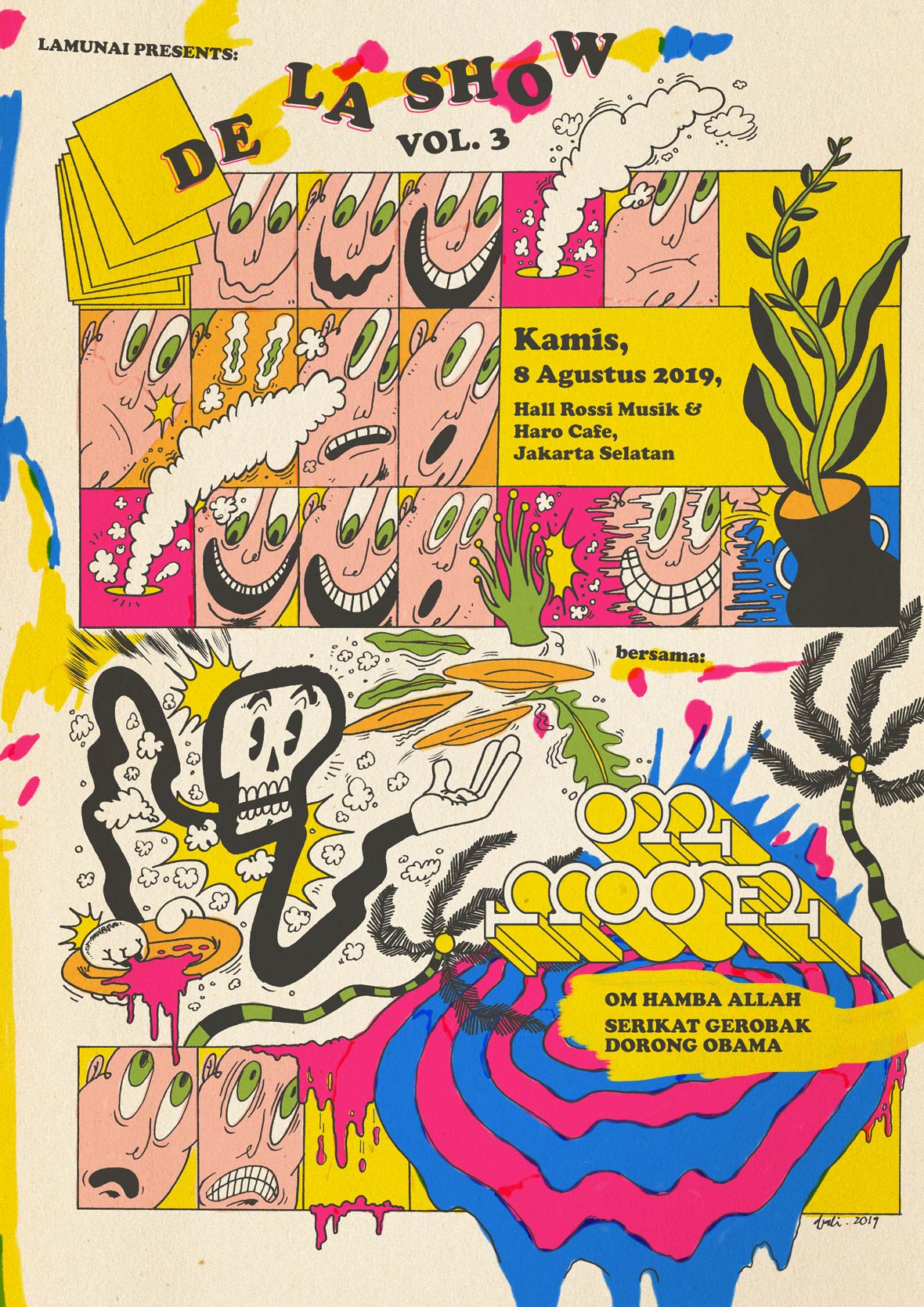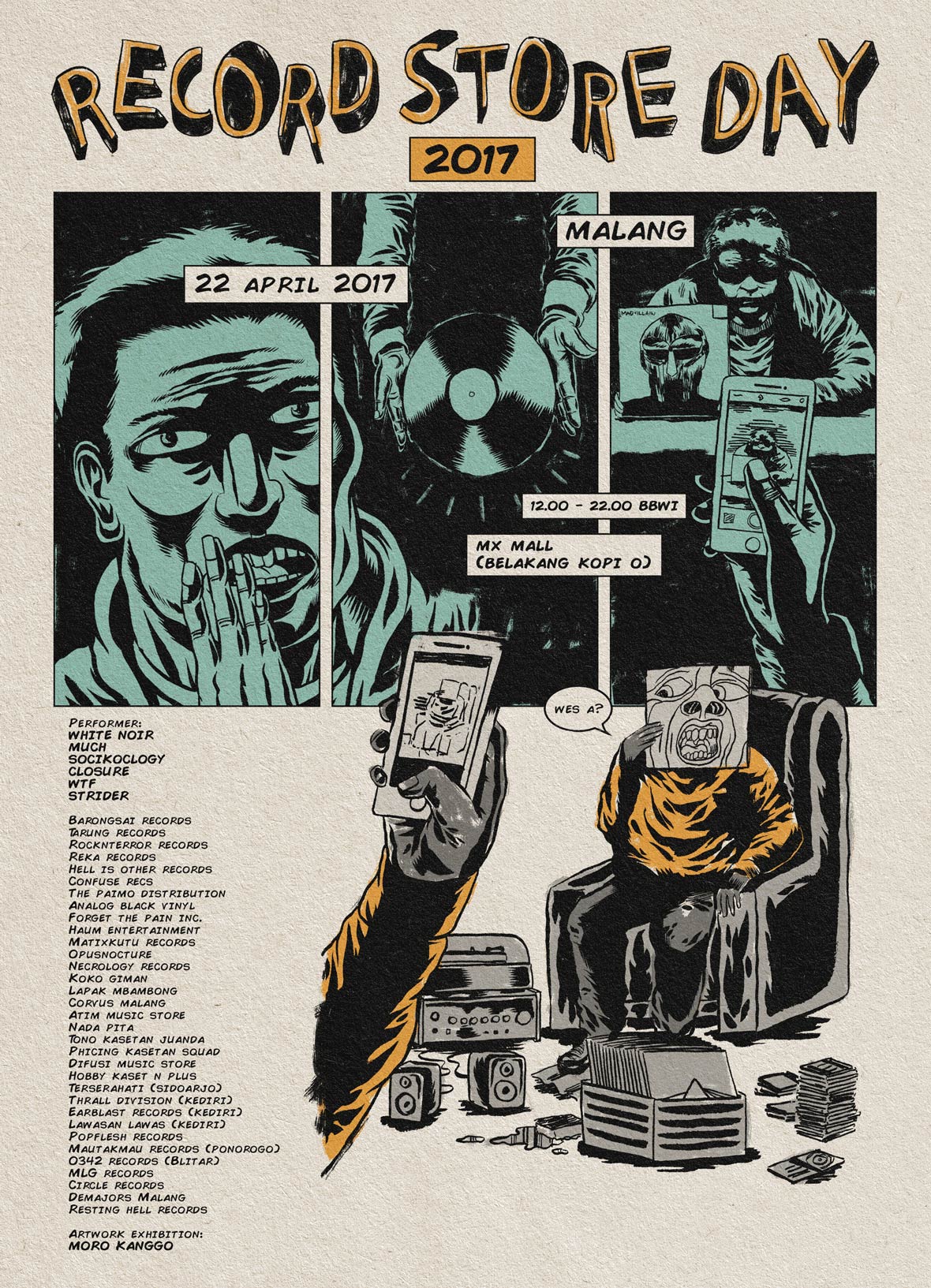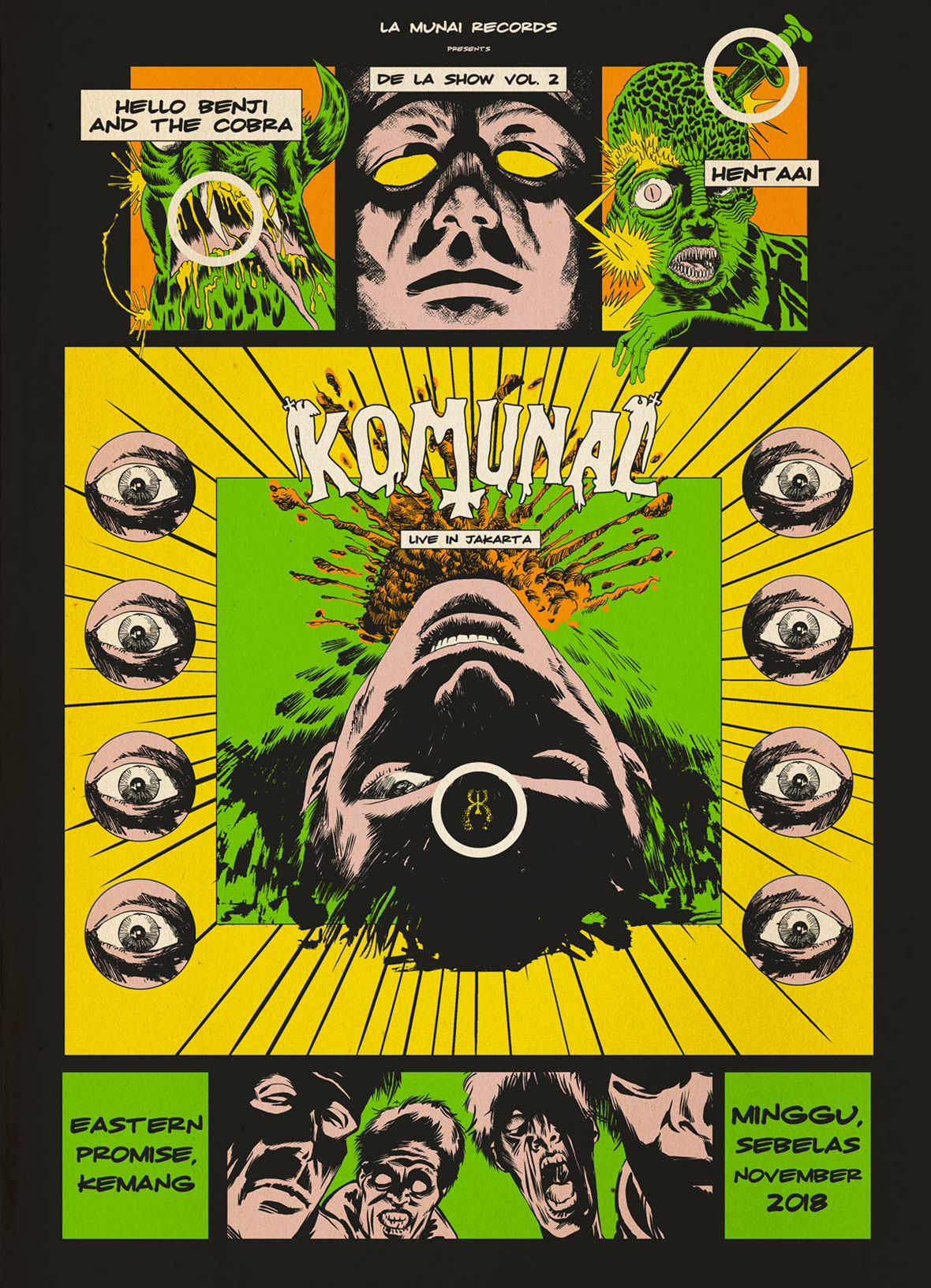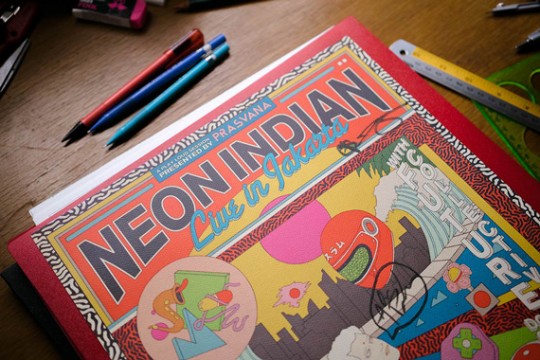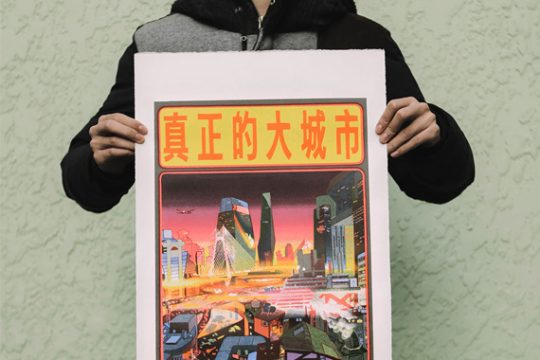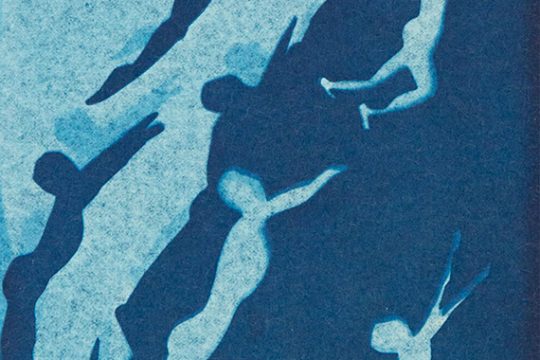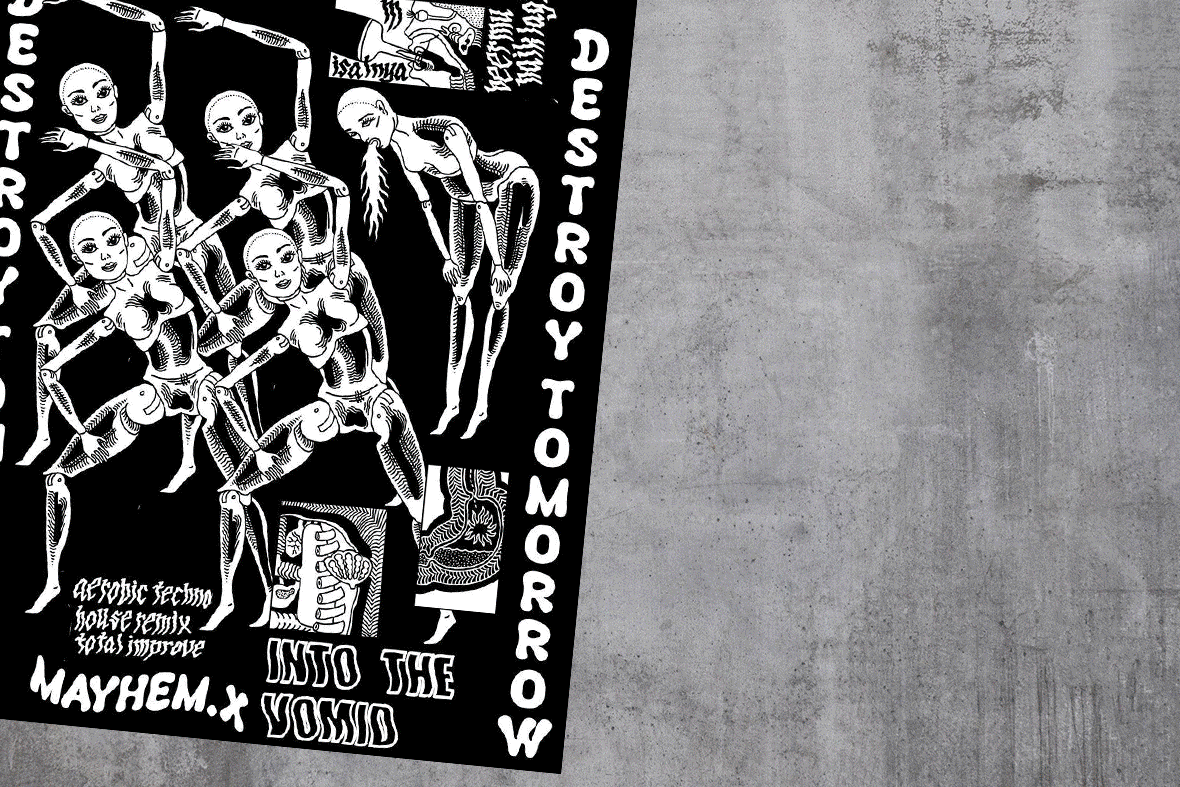
Posters and flyers for album drops and music events once dominated the walls and poles of major cities, and each scene cultivated its own personal visual vocabulary. These days music posters are rare, but in a few places the art form is still going strong, and Indonesian rock is one of the scenes that continues to nurture it. A loose circle of artists spanning at least three major cities produces posters in a distinctive style that references vintage comics, hallucinatory imagery, and Communist propaganda.
It’s hard to say how widespread this culture is, since Indonesia is the world’s fourth most populous country, and its people are spread across 17,000 islands and speak numerous languages. But several artists creating poster and flyer art show evidence of a distinct movement. They’re located in various cities, work within their own music circles, and release their work in different ways, yet the similarities are undeniable: their posters often include superheroes, religious and mythological iconography, psychedelic designs, half-tone coloring, gridded layouts, comic fonts, and bad Xerox textures, and, oddly, Latin American elements like Mexican wrestlers and pyramids.
以前,大城市的墙壁和电线杆上经常会贴满唱片专辑和音乐会的海报及传单,每种音乐自成一派,形成独特的视觉文化。如今,街面上的音乐海报已经很少见到,但在某些地方,这种艺术形式至今依然盛行,譬如在印尼的摇滚音乐圈。三位来自不同都市的艺术家以老式漫画、迷幻图像和共产主义宣传素材,创作出风格鲜明的 “街头告示”。
印度尼西亚是世界第四人口大国,其人口分布于 17,000 个岛屿上,拥有多种语言,因此很难定义这种艺术形式在当地的广泛程度。但是,从几位海报和传单艺术的设计师身上,可以看出这种艺术显然已成为一股鲜明的风潮。他们生活在不同的城市,活跃于不同的音乐圈子。虽然以不同的方式发布作品,但不乏有很多共同之处:形形色色的超级英雄、宗教和神话人物肖像、迷幻图像、半色调着色渲染、网格布局、漫画字体和粗劣的印刷纹理,以及令人意想不到的拉丁美洲元素(例如墨西哥摔跤手和金字塔)。
Many of Indonesia’s most prominent music poster artists are part of Barasub, a Yogyakarta comics and illustration collective. Barasub hopes to host an exhibition or publish a zine about the flyers and posters this year. Previously, they worked with the Yogyakarta gallery Krack Studio on a similar exhibit in 2018, which also featured a residency and art program for local and international artists, helping to nurture the scene.
The late 90s and early 2000s were high points for poster art, and many artists from today’s generation cite that period as an inspiration. Just recently, a curated collection of posters from this time were released in a series of zines called Dinding Ini Milik Kami. Compiled largely from a personal collection of images of Bandung city’s poster art and printed in black and white, it’s a limited but important look into the past.
“For me, that was a golden period. But I do not want to forget the previous generations,” says Chrisna Fernand, founder of Barasub. He says the country’s flyer and poster roots stretch back to the tumultuous period of the 1950s. “Propaganda posters were being made by LEKRA, one of the Indonesian Communist Party’s art divisions. There were several outside artists who were inspirational as well, considering that many countries were experiencing war at the time.” One poster in particular that defines that era is the poster Boeng, Ajo Boeng!, which was meant to illustrate the struggle for justice by the common person. The communists were wiped out by the incumbent government in the 1965 genocide. Fernand also points to the poster art for his country’s films and novels during the 1960s, ’70s, and ‘80s as having important significance to this day.
许多印尼最杰出的音乐海报艺术家都来自 Barasub(日惹的漫画、插画团体)。今年,Barasub 打算以音乐传单和海报为主题,举办展览或出版独立杂志。此前,他们曾与日惹 Krack Studio 画廊合作,在 2018 年举办过一场类似的展览,其中还为本地和外国艺术家提供了驻场和艺术计划,致力推动当地的海报艺术发展。
1990 年代末到 2000 年代初是海报艺术的鼎盛时期,现在许多艺术家都会从那个时期汲取创作灵感。就在最近,一系列名为《Dinding Ini Milik Kami》的独立杂志将这段时期的海报作品重新整理发表,其中主要来自私人收藏的万隆市音乐海报艺术作品,以黑白色印刷,通过数量有限的图片,让参观者重温过去。
“对我来说,那是一段黄金时期。但在那之前,这种艺术已经历过一段时间的发展。”Barasub 的创始人 Chrisna Fernand 说道。他表示,印尼的音乐传单和海报历史可以追溯到 1950 年代的动荡时期。“印尼共产党文宣部门之一 LEKRA 制作了许多宣传海报。当时还有许多国家都在经历战争,这段时期涌现了几位很出色的外国艺术家。”这个时期最有代表性的的海报之一是《Boeng, Ajo Boeng!》,这张海报展现的是平凡人为正义而进行的抗争。在 1965 年的大屠杀中,共产党成员被现任的政府一举歼灭。Chrisna 还指出,二十世纪 60、70 和 80 年代的印尼电影和小说海报艺术在今天也有重要的意义。
One influential contemporary poster artist in Yogyakarta is Dwiky KA. His style, inspired by vintage Indonesian sci-fi, depicts dystopian dreamscapes in warm, earthy colors, where bodies with grotesquely exaggerated limbs writhe in unimaginable contortions. KA got his start in poster and flyer art in 2014 advertising local gigs in his hometown, Surabaya. “The posters at the time were always made with simple digital fonts and collaged objects from the internet,” he says. “I felt this was a crucial problem, because Surabaya has one of the biggest underground music cultures in Indonesia, and it was a pity to not be supported by cool visuals. Good visuals are a weapon to catch the public’s interest, no matter what the event.”
At first, he had to approach musicians, offering to make art for their shows. But by 2017 they were all reaching out to him. A number of other artists shared similar experiences. “It’s a good way for beginner illustrators in need of exposure,” says Dwiky KA. “There are only a few established illustrators who specifically make flyers and posters, but many do the occasional piece for passion projects.”
Dwiky KA 是日惹颇具影响力的当代海报画家之一。他的风格主要受到传统印尼科幻小说影响,以温暖的大地色调描绘反乌托邦的梦幻世界。画面中的人物有着夸张的四肢,以怪诞的姿势地扭曲着。Dwiky 从 2014 年开始从事海报和传单艺术创作,在他的家乡泗水 (Surabaya) 宣传当地的演出。他说:“那时候的海报都是用简单的字体和网上的素材拼贴而成的。我觉得这是个很大的问题,因为泗水有着印尼最大的地下音乐场景之一,但却没有更具个性的视觉艺术来搭配,算是点太可惜了。无论是什么活动,好的视觉艺术都是吸引公众关注的重要工具。”
刚开始,他需要亲自联系音乐家,主动提议为他们的表演创作宣传海报。但是,2017 年,情况扭转了,越来越多音乐家前来找他创作海报。许多其他艺术家也有着类似的经历。Dwiky 说:“对于需要提高曝光度的新人设计师来说,这是个好方法。毕竟只有少数成熟的插画家专门创作传单和海报,大多数人都是偶尔才参与创作一些项目。”

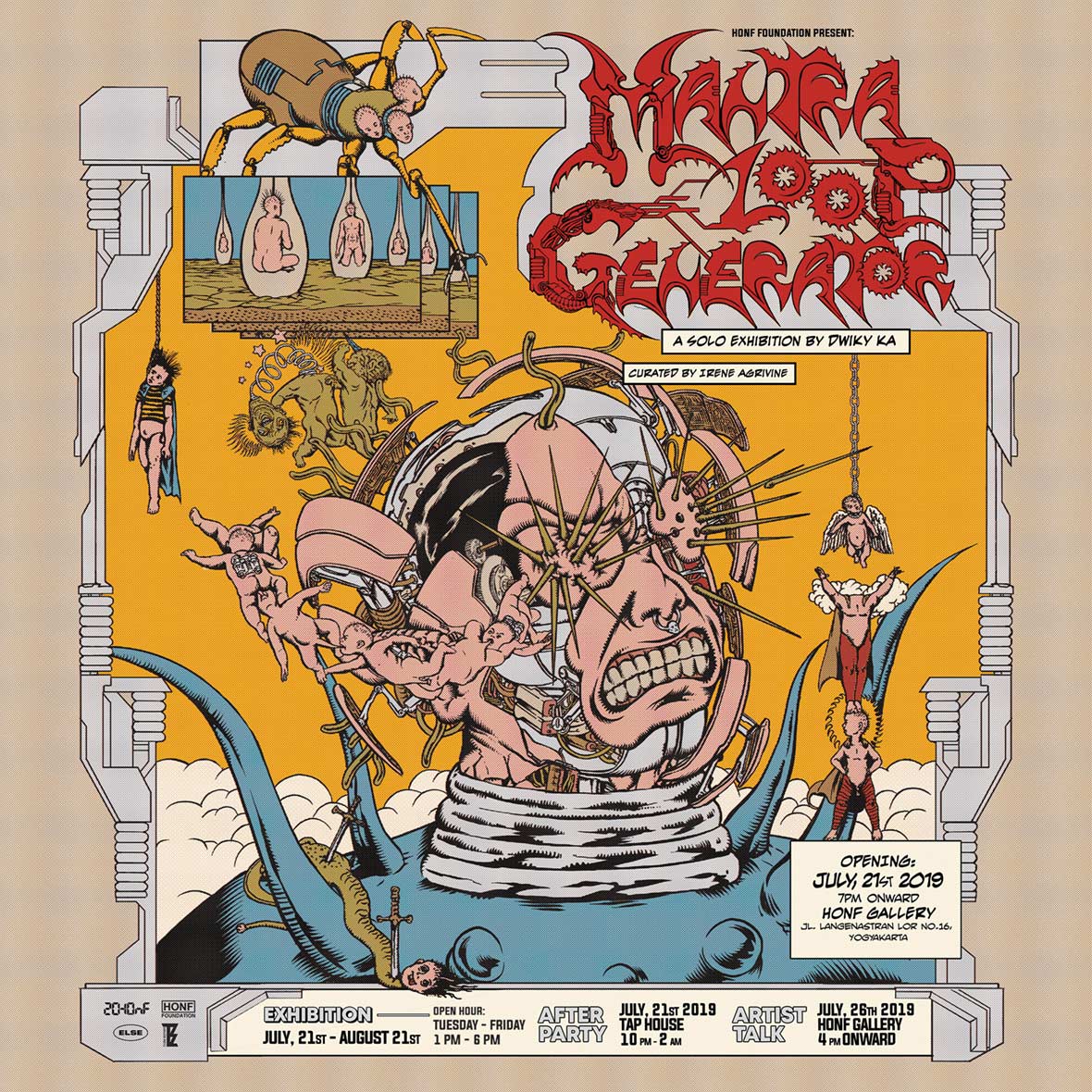
Dolby is an illustrator in Jakarta who works mainly with punk and indie pop musicians. He got his start creating flyers for gigs during college. Dolby uses the clean linework and bold colors popularized by modern digital artists. His work often has repeating patterns that sometimes resemble a tattoo flash card or wallpaper pattern.
Dolby 是一名来自雅加达的插画家,他主要与朋克和独立流行音乐人合作。早在大学期间,他便开始为演出制作传单。现代数字艺术家常见的简洁线条和夸张色彩在他的作品中很常见,同时各种连续重复的图案,看上去像是纹身贴纸或是墙纸图案。
Another notable artist is Supergunz. His style features cartoonish, bubbly characters bouncing off one another, drawn with stark colors and lines tempered by warm tints. He made his first comic when he was 12 and his first flyer for a festival when he was in high school, but he didn’t focus on poster art until after college. He mainly creates posters for rock, punk, and psychedelic bands, and he includes references to punk and metal visual cannons. It’s also overflowing with skeletons and masks, like the kind used in Mexican wrestling.Supergunz says he appreciates the Latinix culture for its intrinsic worth. “It’s just sexy,” he laughs. “It flows well with our own culture.”
另一位著名的艺术家是 Supergunz。他的作品以温暖的色调为主,其中穿插着鲜艳亮色和线条,搭配顽皮嬉闹的卡通角色,非常夺人眼球。12 岁那年,他创作了个人第一本漫画,高中的时候给一个活动画了第一幅传单,但是直到大学毕业后,他才专注于海报艺术创作。他主要为摇滚乐队、朋克乐队和迷幻乐队制作海报,喜欢引用朋克和金属摇滚的视觉元素,还有墨西哥摔跤中常见的骷髅和面具。Supergunz 非常欣赏拉丁文化的内在价值,他笑着说:“拉丁文化热情而迷人,和印尼的文化很契合。”
Most of the work that’s printed is sold as collectibles or merchandise, but some people still bring it back to the streets. “When it’s one of the shows I’m promoting, I’ll post my work up around town,” says Ahmad Rizzali, an illustrator from Jakarta who goes by the artist name Djali. He got his start making flyer and poster art for his own parties in 2015 and now promotes others’ shows too. He’s even worked on a government campaign promoting dangdut, a local style of pop from the ‘70s. His posters stretch the traditional comic book grid format to new and unique forms using bold colors aged with yellowing effects. He also draws on comic books’ inking styles like hatching and contour lines to shade his otherworldly scenes.
Other artists making similar work include Enka Komariah, 80.slut, Mufti Priyanka, and Riandy Karuniawan.
大部分印刷作品都以收藏或商品的形式出售,但总有人希望坚持将这些海报带回街头。雅加达的插画家 Ahmad Rizzali (又名 Djali)说:“如果是我策办的演出,我会在城市四处张贴这些海报。”他从 2015 年开始为自己的派对制作传单和海报,现在也会给其他人的表演制作海报。他甚至参与了政府推广 dangdut 的活动,dangdut 是 70 年代的当地流行音乐。他大胆地以复古的泛黄底色创作海报,将传统网格漫画演绎成新颖独特的形式。他还利用了漫画的描线方式(例如阴影线和轮廓线)来描绘各种虚构的场景。
其他从事海报创作的艺术家还有 Enka Komariah、80.slut、Mufti Priyanka 和 Riandy Karuniawan。
In keeping with the DIY spirit of the music scene they often promote, artists often work with indie printing studios to bring their posters, flyers, and merchandise to life. “I always work with the printers who are my regular friends in the art scene,” Dolby says. “Some of them are so small their businesses are based out of their homes.”
“There’s a bit of a new generation of independent publishing,” adds Fernand, while listing off a number of printers in various cities, in addition to his own Barasub collective. He’s working to push the scene beyond the world of music, with posters created for even more types of events. “We’re making inroads with sequential art and illustration. Sometimes we combine it with performance art, animation, and short films, too. But the print tradition is something we need to strive to further in Indonesia, especially considering so many of our archival zines and independent publishers are gone now.”
为了保持独立音乐场景的 DIY 精神,艺术家们常常会与私人印刷商合作打印海报、传单和艺术商品。Dolby 说:“我一直合作的印刷商也是我在艺术界的朋友。他们的规模都不大,甚至一些人的工作室就在家里。”
Chrisna Fernand 补充说:“现在有了一些新的独立出版商。”除了 Barasub 团队,他还列举了不同城市的多间印刷商。他正在努力将海报艺术推广到音乐以外的更多领域,为更多类型的活动制作海报。“目前,我们也在尝试创作连环画艺术和插图,并尝试将这些作品与表演艺术、动画和短片相结合。但是传统的印刷艺术更需要我们在印度尼西亚进一步推广,毕竟现存的传统独立杂志和独立出版商已经越来越少了。”
Like our stories? Follow us on Facebook and Instagram.
Contributor: Mike Steyels
Chinese Translation: Olivia Li

